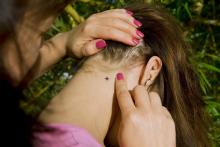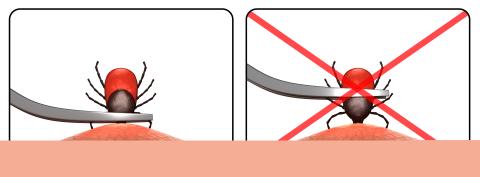Tick Bite Prevention
Fight the Bite
When enjoying time outdoors, be aware of ticks and learn how to protect yourself.
You can take several steps to "fight the bite" and prevent illnesses spread by ticks, including using personal protection, removing ticks as soon as possible, and getting rid of ticks in your yard. Ticks are typically most active in Wisconsin from May to November, but you should use caution throughout the year.
If you spend a lot of time outdoors, download The Tick App. It’s a free app from our partners at the Midwest Center of Excellence for Vector-Borne Disease. The app allows people living in areas with a high risk of Lyme disease to report ticks and learn tick bite prevention tips. The app also helps researchers understand ticks and the illnesses they spread.
Personal protection
There are many steps you can take to protect yourself from tick bites.
Use insect repellents on exposed skin and clothes to prevent tick bites. Repellents should contain one of these:
- 20–30% DEET
- 10–20% Picaridin
- 15–20% IR3535
- 30–40% oil of lemon eucalyptus
Parents should apply repellents to children. Use caution and avoid hands, eyes, and mouth. Don’t use oil of lemon eucalyptus on children under 3 years of age.
Permethrin is a pesticide that kills ticks when they crawl on your clothes. Apply it to clothes, shoes, and gear to prevent tick bites. Don’t apply directly to skin. After applied, permethrin lasts through several washes.
Carefully apply repellents according to the label instructions. Some products should be applied more often than others.
Find the Repellent that is Right for You on the Environmental Protection Agency website.
For more details, visit our webpage on Tick and Insect Repellents. Learn more with the Insect Repellent Essentials: A Brief Guide (PDF) from the Northeast Regional Center for Excellence in Vector-borne Diseases.
- Wear long sleeves, long pants, and tall socks. This helps keep ticks on the outside of clothing rather than on your skin.
- Wear light-colored clothing to make ticks easier to spot.
- Tuck shirts into pants, and tuck pants into shoes or socks. This keeps ticks on the outside of clothing.
- Take extra care if you’ll be outdoors for a long time. Tape pant legs where pants and socks meet so ticks can’t crawl under clothes.
- Walk in the center of trails
- Don't brush up against plants on the edge of trails.
- Avoid wooded and brushy areas with tall grass and leaf litter.
- Perform full-body tick checks after being outdoors in areas where ticks may be present. This could include your own yard. Check yourself and family members every day after being outdoors where ticks may be present.
- Check all parts of the body carefully. Pay special attention to the armpits, behind the knees, scalp, in and around the ears, inside the belly button, and groin.
- Parents should check their children for ticks.
- Before going inside, make sure your clothing, gear, and pets don’t have ticks. For pets, use a treatment recommended by a veterinarian to prevent ticks.
- Take a bath or shower within two hours after coming inside. This helps you find and wash off any ticks on your body.
- Tumble dry clothes in a dryer on high heat for 10 minutes. The heat kills any ticks still on your clothing. If clothes are damp, tumble dry on high heat for 60 minutes.
Tick removal—dos and don'ts
Don't panic if you find a tick embedded on your body. Simply remove it as soon as possible following these recommendations:
Do:
- Grasp tick with a narrow-bladed tweezers as close as possible to the skin.
- If tweezers are not available, use fingers shielded with tissue paper or rubber gloves.
- Pull upward and out with a firm and steady tension.
Don't:
- Don't use petroleum jelly, a hot match, nail polish, or other products.
- Don't handle tick with bare hands.
- Don't squeeze, crush, or puncture the body of the tick, which may contain infectious fluids.
- Don't twist the tick, since this can cause the mouthparts to break off and stay in the skin.
After removing the tick, use rubbing alcohol to clean the bite site and wash your hands with soap and water. It is important that a tick be properly removed as soon as it's found.
Visit your doctor if you have a rash or fever within 30 days of removing a tick or after possible tick exposure. Tell the doctor when and where you may have come into contact with the tick.
If I've been bitten by a tick, should I get it tested?
If you have been bitten by a tick, getting it tested for any diseases isn't recommended. The only way to know if a tick bite made you sick is through an evaluation performed by a health care provider. Learn more about tick testing at Ticks in Wisconsin: What You Need to Know.
Tick control
Easy ways to lower the number of ticks in the environment where you live or work:
- Clear tall grass, brush, and leaf litter from the yard or trails.
- Use wood chips or gravel as a barrier between lawns and wooded areas. Use it around patios and play equipment. The CDC (Centers for Disease Control and Prevention) recommends a three-foot-wide barrier to prevent ticks from entering recreational areas.
- Mow lawns often. Remove cut grass and leaves.
- Keep tables, swing sets, and other play equipment away from woods, shrubs, and tall grass. Place in a sunny location, if possible.
- Don’t feed deer. They often carry ticks into the yard. Build barriers to keep deer from coming into the yard.
- Remove woodpiles. If you must stack wood, place it neatly in dry areas away from houses. This will lower the number of rodents in the area. Rodents can bring ticks into the yard. Rodents also spread disease to ticks.
To reduce the number of ticks in your yard, apply pesticides that kill ticks in springtime.
Before using pesticides, speak to a professional pesticide company. Consider hiring them to treat your yard.
The U.S. Environmental Protection Agency, along with each state, have regulations for pesticide use at your home. Learn about these rules these before you use any pesticides.
For more information, visit the Environmental Protection Agency’s website on Pesticides.
Resources
- Education on the risk of illnesses spread by ticks—Tickborne Diseases Risk in Wisconsin, P-01751 (PDF)
- Education on tick bite prevention and the DHS Tick Identification Service — Tick Bite Prevention, P-01751A (PDF)
- Education tri-fold card about ticks in Wisconsin, proper tick removal, and tick bite prevention—Tick Safety Guide, P-01434 (PDF)
- Education flyer—Lyme Disease Risk in Wisconsin, P-01752 (PDF)
- Lyme disease signs and symptoms, treatment, and prevention—Lyme Disease Fact Sheet, P-42070
- Anaplasmosis and ehrlichiosis signs and symptoms, treatment, and prevention—Anaplasmosis and Ehrlichiosis Fact Sheet, P-42045
- Babesiosis signs and symptoms, treatment, and prevention—Babesiosis Fact Sheet, P-42028
- DHS offers a fast and simple Tick Identification Service based on a few questions and photographs you submit online. You can send a submission if you live in Iowa, Illinois, Michigan, Minnesota, and Wisconsin.
Order free resources from DHS. Here’s how:
- Download our Forms/Publications Order, F-80025A (Word) Use this form to order multiple forms and publications at once.
- Complete the form by using the tab key to work through the input fields. Don't use the return or enter key.
- Email the completed form to dhsfmorder@dhs.wisconsin.gov.
If you have questions about ordering forms or publications, email us at dhsfmorder@dhs.wisconsin.gov or call 608-266-8502.
- Preventing Ticks on Your Pets
- Fact sheet on tick bite prevention for hunters—It’s Open Season on Ticks (PDF)
- Plastic trail sign to remind hikers there are ticks in the area—Prevent Tick Bites (PDF). Order the sign from CDC Publications on Demand.
- Fact sheet on steps to take after a tick bite—Tick Bite: What to Do (PDF)
- Educational comic for kids—Don’t Let a Tick Make You Sick (PDF)
- Educational crossword for kids—Don’t Let a Tick Make You Sick (PDF)
- Rap video from Fairfax County Health Department in Virginia, with tips on how to protect yourself from tick bites—Tick Check 1–2
- Ways to prevent tick bites from our partners at the University of Wisconsin-Madison Medical Entomology Laboratory—Tick-Borne Disease Prevention
- Information and tick control tips from the National Pesticide Information Center—Ticks and Tick Bites
Contact us
Questions about illnesses spread by ticks? We’re here to help.
Bureau of Communicable Diseases
Phone: 608-267-9003
Fax: 608-261-4976





